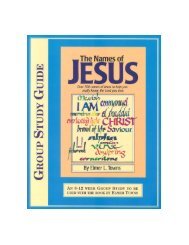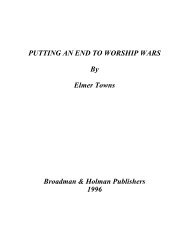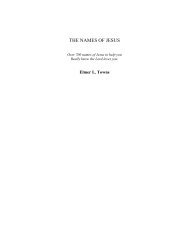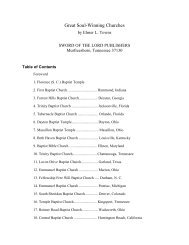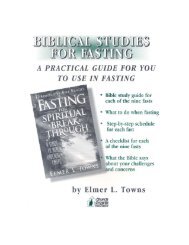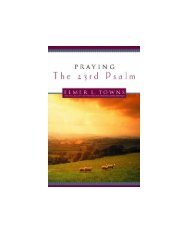A Journey Through The Old Testament - Elmer Towns
A Journey Through The Old Testament - Elmer Towns
A Journey Through The Old Testament - Elmer Towns
Create successful ePaper yourself
Turn your PDF publications into a flip-book with our unique Google optimized e-Paper software.
most impressive Pharaohs of Egyptian history. Conservative scholars tend to identify Hatshepsut<br />
with the daughter of Pharaoh who found the baby Moses in the Nile River.<br />
Hatshepsut was followed by Thutmosis III, the Pharaoh of oppression (1504-1450 B. C.).<br />
Actually, he was a co-Pharaoh with Hatshepsut for much of his reign but did not have liberty to<br />
act on his own as Pharaoh until the death of Hatshepsut. <strong>The</strong>n he acted with a vengeance to<br />
destroy every memory of Hatshepsut. He defaced the buildings she had built and scratched her<br />
name off any monuments. If the conservative chronology is correct, it was this Pharaoh who<br />
sought to destroy Moses for killing an Egyptian slave master and who must have died just prior<br />
to God calling Moses back to Egypt.<br />
Thutmosis III was followed by Amenhotep II, the Pharaoh of the Exodus (1450-1415<br />
B.C.). Though the Egyptian chronicles record many of the athletic exploits of this Pharaoh as a<br />
young man, it is strangely silent on any great accomplishments during his reign. He apparently<br />
fathered a son, but that son never became a Pharaoh. All of the mystery surrounding Amenhotep<br />
II fits in perfectly with the events which not only marked the historic birth of the nation Israel,<br />
but also must have resulted in a traumatic social and economic crisis for the Egyptians, the<br />
Exodus (1445 B.C.).<br />
<strong>The</strong>re is a tendency among liberal scholars to date the Exodus much later in Egyptian<br />
history, during the reign of Raamses II (1280-1220 B. C.). <strong>The</strong>re are several problems with this<br />
view. First, it contradicts the only biblical hints of the date of the Exodus. Galatians 3:16-17; 1<br />
Kings 6:1; and Judges 11:26 each allude to chronological details which suggest the date 1445 B.<br />
C. Further, at least two archeological discoveries are more harmonious with an earlier rather than<br />
a later date for the Exodus. <strong>The</strong> Stele of Mernaptah dated 1218 B. C. lists Israel as one of the<br />
peoples firmly established in the land of Palestine at that time. Also, the earlier date is more<br />
consistent with the apparent time of the destruction of Jericho.<br />
PREPARATION FOR DELIVERANCE<br />
(Ex. 1:7-2:25)<br />
As Egypt was adjusting to a new era in their long and rich history, God was preparing to<br />
bring His people out of that land into the land He had promised Abraham. <strong>The</strong> preparations<br />
began over eighty years before the actual Exodus took place. First God had to find midwives<br />
who would trust Him and defy the order of the Pharaoh that all male children be killed at birth.<br />
<strong>The</strong>n He had to find a couple who would preserve the life of their son when the order to drown<br />
male children was made, and who by faith would raise that son to have the values that would<br />
help him make the right choices during the later crises of his life. Gradually, everything came<br />
together. <strong>The</strong>re were midwives like Shiphrah and Puah who believed it was more important to<br />
preserve life than to destroy babies on the order of an Egyptian Pharaoh. <strong>The</strong>n one day it<br />
happened. In the home of Amram and Jochebed, a son was born.<br />
For a while, the parents could hide their child from the authorities. It was not easy, but it<br />
was necessary. If the authorities learned a son had been born to them, that son would have been<br />
drowned in the Nile River. So, while like other parents they longed to share their joy with others,<br />
to preserve the life of their son they abstained from telling others of his birth.<br />
Soon it became impossible to keep the secret. When the child got hungry, he became<br />
vocal. His cry for food endangered his very existence. Still, the deepest longing of his parents<br />
was that his life be spared, regardless of the cost to them personally. Soon a plan was devised<br />
and initiated by the child’s mother.




